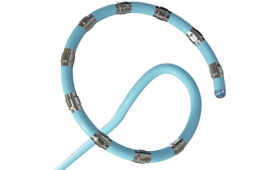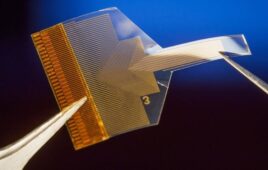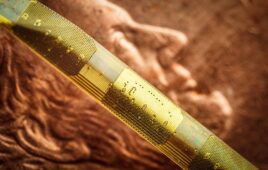
Mehran Mehregany | Director of the Case School of Engineering | San Diego
There are strong indications in the marketplace that a digital healthcare revolution is coming (often referred to as wireless, digital, or mobile health). The basic idea is to wirelessly connect the patient with care providers to monitor their health and intervene as needed – ideally preventatively – as the patient goes about their normal life. The enabling technology to do so would rely on miniature, smart sensors incorporated around (deployables), on (wearables) and inside (implantable) the patient. Wearables are attractive, because they require no medical procedure and travel with the patient. The rest of this article provides an overview of sensors, wearables, and wireless health.
Sensors
Miniature, smart sensors are based on micro- and nanofabrication technology, often simply referred to as MEMS (micro-electro-mechanical systems) and NEMS (nano-electro-mechanical systems). These devices—in the form of sensors and actuators—augment the computational ability of microelectronics with perception (i.e., sensing) and control (i.e., actuation) capabilities. To do their work, sensors and actuators require a transduction mechanism, such as that often provided by a mechanical element in the physical sensors. Generally stated, the transduction mechanism converts nonelectrical parameters to electrical ones in a calibrated way.
MEMS sensors and actuators have been commercialized in a wide range of applications since the 1970s, including pressure measurement, motion sensing, optical projection, and fluid-flow control, to name a few. Silicon, in single and polycrystalline forms, has been the platform semiconductor material underpinning the mechanical and electronic elements of micro and nanosystems. MEMS pressure sensors gained commercialization momentum in the 1980s as they entered automotive (e.g., manifold absolute pressure sensors) and medical applications (e.g., disposable blood pressure sensors). MEMS accelerometers gained momentum in the early 1990’s as they entered the automotive market in crash detectors, followed by MEMS angular rate sensors, also called gyroscopes, in the late 1990’s. MEMS microphones entered the consumer market in mobile phones and other devices in the 2000’s.
With over 40 years of commercialization history behind it, MEMS sensor design and manufacturing advances have enabled consumer electronics volume, pricing, and performance. The MEMS industry is bullish on the prospects for a wide range of sensors. There is indeed gathering momentum to develop a trillion-sensors road map.
Wearables
Wearables are a new application domain for MEMS sensors, with momentum rooted in activity monitors—initially standalone devices and now transitioning to smart watches. Activity monitors leverage the volume, pricing, and performance of MEMS accelerometers. In these devices, physical activity is correlated with health and wellness and can be accomplished by using a MEMS accelerometer to sense motion and a suitable algorithm to translate the sensor data into activity information, which can also be used to estimate calorie consumption. Wearables that similarly leverage commodity MEMS devices are quickly becoming a commodity themselves. Such wearables differentiate themselves mostly by their user interface engineering and business model.

The four Fitbit models provide examples of wearable devices. MEMS devices let the units measure steps taken through the day, stairs climbed, and (at right) heart rate. Blood pressure has been an elusive measurement for wearable devices and awaits it sensor’s development.
Wearables are mostly motivated in the marketplace by their potential for health and wellness applications. They are attractive compared to implantable sensors, particularly when nonintrusive and inconspicuous. Implantable sensors require intrusion into the body, forcing substantially more stringent performance, size, and reliability requirements. The regulatory approval for medical wearables can be, by comparison, much cheaper and faster.
In general, MEMS technology is application-driven and technology-limited. To harvest new application opportunities, wearables need a wide range of sensors – including chemical and biological—many of which are not yet available in consumer volume, pricing, and performance. Many such sensors are undergoing R&D, and many have not yet been identified. Many such MEMS devices will be challenged in part by packaging issues. Furthermore, thermal management is more stringent in wearables than the historical applications for MEMS devices, in particular for medically regulated wearables.
Nevertheless, smart watches are moving rapidly to integrate new sensors for monitoring additional vitals, motivated by a goal of displacing simpler activity bracelets. For example, current smart watches are integrating sensors for pulse and blood oxygen. Cuffless, continuous blood-pressure monitoring is an extremely attractive function, but technology to accomplish it is not yet available.
Wireless health
Ubiquitous connectivity and computing are bringing about unprecedented mobility—facilitating working, entertainment, shopping, socializing, gaming, and more, anytime, anywhere. Wearables enable wireless health, which in turn enables diagnosis, therapy, and monitoring of health-related conditions by tracking biometric readings, relevant biomarkers, managing treatment regimen, and monitoring progress—while patients go about their daily life. Continued emergence of wireless health is a near certainty, given its significant potential benefits to healthcare delivery systems and increasing patient demand for mobility.
The projection for the 2015 annual heath care expenditure in the United States is about $3.2 trillion–breaking the $10,000-per-person mark and well above other developed countries. Healthcare spending has grown between 3% and 4% in recent years, taking between 17% and 18% of the GDP.
The U.S. healthcare system’s fee-for-service model is reactive to illness. An aging population, longer lives, and increasing cases of chronic diseases are some of the key drivers escalating healthcare expenditures. Chronic diseases—hypertension, obesity, arthritis, asthma, chronic kidney disease, depression, chronic obstructive pulmonary disease, diabetes, sleep disorder, and heart failure—account for a sizable portion of the U.S. healthcare expenditures. That portion is one-third to three-quarters, depending on the source. About 45% of the U.S. population has at least one chronic disease, and about 50% have two or more.
Generally speaking, there are three basic approaches to wireless health devices: app-driven, device-driven, and service-driven.6 Solutions often combine permutations of two or all of these approaches, to solve more complex needs, enhance differentiation, rationalize higher prices, and increase barrier to entry of competitors.
Because external devices are usually sensors—to make measurements—the terms ‘sensor’ and ‘device’ are used interchangeably here. Focusing on solutions enabled by external devices is not exclusive to also using a phone’s embedded sensors. It should be noted that external devices may be peripherals, such as biometric data routers, that facilite the transmission of data from sensors.
Apps may originate from payers, providers, or third parties. Providers are increasingly branding their own apps to engage their patients and enhance their services. Inevitably, these provider apps will tie into the provider’s electronic records, providing access to the patients. Payer apps enhance external-facing service enhancements for patients and providers. Third-party apps that facilitate a variety of workflow, engagement, and care delivery needs may be for payers, providers, and patients to provide.




